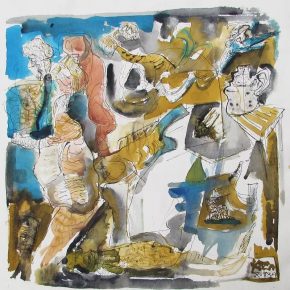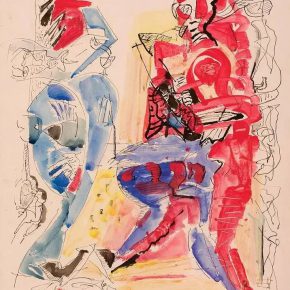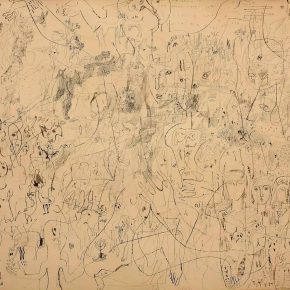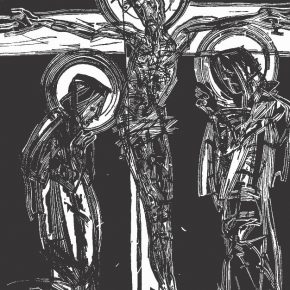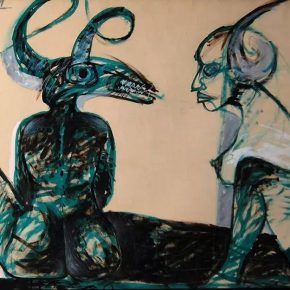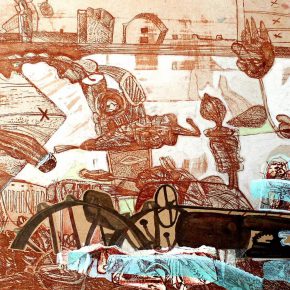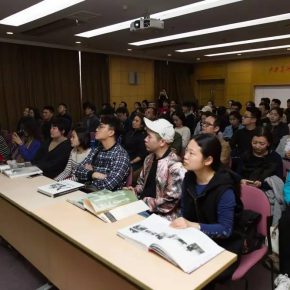
From 15:00 to 17:00 on April 12, 2017, the lecture entitled “One Hundred Years of Romanian Prints” was held at the lecture hall of the CAFA Library, invited Constantin Lupeanu, Director of the Romanian Center for Culture in Beijing, the famous Sinologist from Romania, a member of the Romanian Writers Association, one of the founders of the Romania-China Economic and Cultural Friendship Association, to give a lecture. The lecture was organized by the Office of International Cooperation and Exchange at the Central Academy of Fine Arts and it was hosted by Prof. Zhang Ye, Deputy Director of the Department of Printmaking at the Central Academy of Fine Arts.
The lecture started from the national conditions in Romania and Constantin Lupeanu introduced the origins of the Romania – the ancient Dacia. In 70 BC, it established the first centralized and independent Dacia Country in the Romanian land, Dacia was then conquered by the Roman Empire in 106 AD, it then became a province of the Roman Empire. After that the people from Dacia became mixed and gradually integrated with the Romans, thus forming the Romanian nation. Romania means “Romanian country” in Latin. Romania is an Eastern Europe nation, with the majority of the population in the country consisting of Romanians. The country is rich in resources from the forests, so the majority of the national buildings are made of wood. Because it often snows in winter, the wooden building construction creates a large sloping roof. Due to medieval warriors, a relatively stable national architectural style was not formed until the 15th century. Romania believed in the Orthodox Eastern Church, so many famous buildings are Orthodox churches. Constantin Lupeanu then introduced a number of outstanding Romanian national painters, and delivered a report entitled “Romanian Image Art of the Second Half of the 20th Century and Four Generations of Illustrators.”
"Romanian visual art has played an important role during the two world wars. Whether it is modern art or avant-garde, especially Dadaism, they all tried to restore, adjust and build a new local art school... the Romanian School of Contemporary Graphics, which has been increasingly perfected, has been established for more than 70 years, and is divided into four generations, the representatives of the latter three generations are still alive which has produced a mentoring relationship, indicating the continuity of the artistic tradition.”
The lecture started from this, travelling through the works by seven art designers to summarize the development and evolution of Romanian graphic arts over the last half century.
He first introduced the artist Vasile Kazar who is considered the founder of the Romanian School of Contemporary Graphics. He survived the Second World War and was in a Nazi concentration camp, but survived the Jewish massacre. His work is considered an imaginative personal world which is the re-combination of fragments of a fabulous memory, by the artistic critic George Vader. When he taught in the most prestigious Romanian art institute – “Nicolae Grigorescu” academy of fine arts, he trained a number of excellent talented artists for the Romanian art world. Art critic Pawel Susala commented that he “used a style of autonomic art and independent language to perfect the dignity of Romanian art and has trained several generations to become masters of art and design.”
Then he introduced two artists – Octav Grigorescu and Mircia Dumitrescu who both graduated from Nicolae Grigorescu Institute, they were both students of the great artist Vasile Kazar, the former is both a successful master of design and a writer. “In the designer’s personal life and artistic career, he encountered a collision between avant-garde thought and nostalgic ideological trend. He was perplexed by the victory of modernism and tries to avoid the lack of art caused by the destruction of the 19th century.” Mircia Dumitrescu is also a literary lover. They both worked in the illustration of literary works, but the styles are different. The relationship between the former text and illustration is relatively casual while the latter is relatively concrete.
The fourth artist Aurel Bulacu is also a student of Vasile and a classmate of Mircia. The works recently created by Bulacu are related to ghosts and gods, and he created the monster “Chimeras” which means the “mother goat” in Greek, from ancient Greek mythology. In the process of creating the “Chimeras”, the creator fantasized about specific things and it started from a personal art perspective in the entire creative process, with heavy personal color.
Ioan Delamare Atanasiu is the most important graphic art designer in Romania. His understanding of reality and freedom overlaps and is reflected in the design and it can be interpreted although it is difficult for people to understand; Ion Creang?’s image works is heavy, the relationship between various parts is very charming, architecture and graphic art meet at the ideological level and the whole work has a strong philosophical quality, while the virtual architectural painting is a major feature of his creation.
The speaker finally introduced the artist Nicolae Alexi, who has an unique style, and he is often compared with Salvador Dali. Appreciating Nicolae's works would always bring surprises, while his work is also a continuous narrative that involved the audience. The form of his works is postmodern, based on the ancient visual language to rethink the personal view, which is very concrete. Nicolae was good at design to narrow the distance between the Renaissance and Baroque styles and the audience. He is also a painter who loves life and is good at portraying real life. We can understand his era by observing his paintings.
At last, Constantin Lupeanu said that, “The Romanian graphic arts is far more than just the seven cases which are the most representative ones. Romanian prints are still continuing to inherit traditions, getting rid of?the?stale?and?bringing?forth?the?fresh, creating more and better works.”
At the end of the lecture, Prof. Zhang Ye, Deputy Director of the Department of Printmaking gave a conclusion and suggested that the contemporary students from the Central Academy of Fine Arts should have a vision of the overall situation of the “time and space”. “Time” pays attention to both focusing on the past and living in the moment, concerning reality, like Nicolae Alexi; and “space” does not only pay attention to the art of big countries as dominated by the United States, it also dabbles in the extensive national art from various countries. This lecture helped the teachers and students from CAFA to have a certain degree of understanding and knowledge of Romanian art, and also deepened their understanding of the country of Romania.
Text by Liu Guannan and edited by Lin Jiabin, translated by Chen Peihua and edited by Sue/CAFA ART INFO
Photo by Yang Yanyuan/CAFA ART INFO
(Works come from the internet)???



